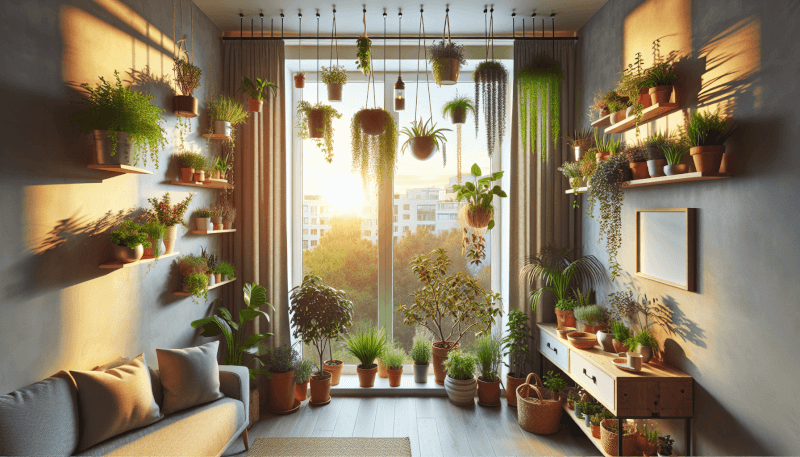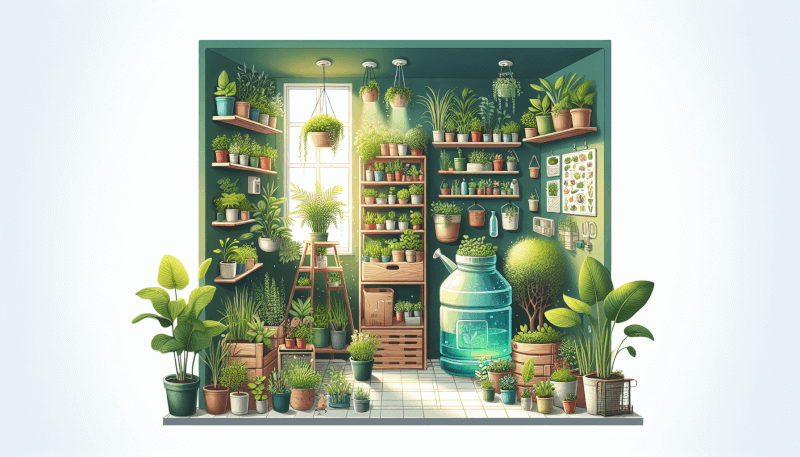Imagine transforming your small apartment into a lush oasis with a thriving garden. Even with limited space, you can create an enchanting haven filled with colorful blooms and bountiful herbs. This article will guide you on how to cultivate your own small apartment garden, providing you with practical tips and creative ideas to make the most of your space. Get ready to discover the joy of gardening right at your fingertips, and watch as your tiny living space blossoms into a beautiful, green sanctuary.

Types of Small Apartment Gardens
Balcony Garden
A balcony garden is a great option for those living in apartments with balconies or outdoor spaces. This type of garden utilizes the space on your balcony to create a green oasis. With the right plants and containers, you can transform your balcony into a serene and inviting space. Whether you have a small balcony or a larger one, there are various balcony gardening ideas that can suit your needs and preferences.
Window Sill Garden
A window sill garden is perfect for those who have limited outdoor space but still want to enjoy the beauty and benefits of gardening. This type of garden utilizes the space on your windowsill to grow a variety of plants. Whether you have a sunny window or a window with limited light, you can find plants that thrive in different lighting conditions. A window sill garden not only adds a touch of greenery to your apartment but also allows you to enjoy the beauty of nature from the comfort of your home.
Vertical Garden
A vertical garden is a space-saving solution for small apartment gardens. This type of garden utilizes vertical space, such as walls or fences, to grow plants vertically. By using hanging baskets, wall planters, or trellises, you can maximize your gardening space and create a stunning vertical display. Vertical gardens not only add visual interest to your apartment but also provide a practical way to grow herbs, flowers, or even vegetables in a limited space.
Choosing the Right Plants
Considering Lighting Conditions
When selecting plants for your small apartment garden, it’s important to consider the lighting conditions in your space. Different plants have different light requirements, ranging from full sun to low light. If your balcony or window receives direct sunlight for most of the day, opt for plants that thrive in full sun. On the other hand, if your space is shaded or receives limited sunlight, choose plants that can tolerate low light conditions. By matching the plants to the lighting conditions, you can ensure their healthy growth and overall success of your garden.
Determining Plant Size
The size of your apartment garden will determine the type and size of plants you can grow. For small spaces, it’s best to choose compact varieties or dwarf versions of plants that won’t outgrow your containers or vertical structures. Look for plants labeled as “patio” or “dwarf” varieties, as they are specifically bred to thrive in small spaces. Additionally, consider the mature size of the plants before purchasing them to avoid overcrowding and to ensure they have enough space to grow and flourish.
Selecting Low-Maintenance Plants
If you have a busy lifestyle or limited gardening experience, selecting low-maintenance plants for your small apartment garden is a wise choice. Low-maintenance plants require minimal care and can thrive even with irregular watering or inconsistent light conditions. Some examples of low-maintenance plants include succulents, snake plants, pothos, and ZZ plants. These plants are known for their resilience and ability to thrive in various environments, making them perfect for apartment dwellers who want a hassle-free gardening experience.
Creating a Container Garden
Choosing the Right Containers
Choosing the right containers is crucial for the success of your small apartment garden. Consider the size, material, and style of the containers when making your selection. Make sure the containers have drainage holes to allow excess water to escape and prevent waterlogged roots. Opt for lightweight containers if you have a balcony garden to avoid adding unnecessary weight. Additionally, consider using hanging baskets, vertical planters, or window boxes to maximize your space and create a visually appealing garden.
Ensuring Proper Drainage
Proper drainage is essential for the health of your plants. Without it, excess water can accumulate in the containers, leading to root rot and other water-related issues. Ensure that your containers have drainage holes or consider creating a drainage layer at the bottom of the containers using materials like pebbles or broken pottery. This layer will allow water to flow freely and prevent waterlogging. Additionally, avoid overwatering your plants and maintain a consistent watering schedule to promote healthy plant growth.
Using the Right Soil Mix
Choosing the right soil mix is important for the overall health and growth of your plants. Opt for a high-quality potting mix specifically designed for container gardening. These mixes are lightweight, well-draining, and enriched with essential nutrients. Avoid using garden soil, as it can be heavy and may not provide adequate drainage for potted plants. You can also consider adding organic matter, such as compost or peat moss, to improve the soil’s fertility and moisture retention.

Arranging and Designing Your Garden
Grouping Plants by Light Requirements
To ensure all your plants thrive in your small apartment garden, it’s essential to group them based on their light requirements. Place plants that require full sun together in a spot that receives direct sunlight for most of the day. Similarly, group plants that prefer shade or low light conditions in a suitable area of your balcony or near a window with limited sunlight. By organizing your plants according to their lighting needs, you can provide them with the optimal growing conditions and prevent any plants from being overshadowed or deprived of sunlight.
Creating Visual Interest with Different Heights
Designing your small apartment garden with different heights adds visual interest and makes the space look more appealing. Utilize plant stands, shelves, or even repurpose furniture to create different levels for your plants. Place taller plants towards the back or center of your garden and shorter plants towards the front or edges. This layering effect creates depth and dimension, giving your garden a more lush and layered appearance. Additionally, consider using trailing or cascading plants to add vertical interest and soften the edges of your containers or vertical structures.
Incorporating Decorative Elements
Elevate the aesthetics of your small apartment garden by incorporating decorative elements. Add colorful planters or containers to create a vibrant and lively atmosphere. Consider using decorative stones, pebbles, or mulch to cover the soil surface and give your garden a more polished look. You can also hang decorative lanterns, wind chimes, or fairy lights to create a cozy and inviting ambiance. By adding these decorative touches, you can personalize your garden space and make it a reflection of your style and personality.
Caring for Your Small Apartment Garden
Watering and Moisture Levels
Proper watering is crucial for the health and growth of your small apartment garden. Pay attention to the specific watering needs of each plant and establish a watering routine accordingly. Avoid overwatering by allowing the top inch of soil to dry out between waterings. Use your finger to check the soil moisture level or invest in a moisture meter for more accurate readings. Additionally, consider using a watering can or a small hose attachment with a gentle spray to ensure even distribution of water. Remember, the moisture requirements may vary depending on the season, so adjust your watering schedule accordingly.
Fertilizing and Nutrient Needs
Small apartment gardens often rely on container gardening, which means the nutrients in the soil may deplete faster due to limited space and regular watering. Supplementing your plants with fertilizers is essential to replenish the nutrients and promote healthy growth. Use a balanced, slow-release fertilizer or opt for organic options such as compost tea or seaweed extract. Follow the instructions on the fertilizer packaging for application rates and frequency. Avoid overfertilizing, as it can lead to nutrient burn and other plant health issues. Regularly monitor your plants for any signs of nutrient deficiencies, such as yellowing leaves or stunted growth, and adjust your fertilizing routine accordingly.
Pruning and Deadheading
Regular pruning and deadheading are necessary to maintain the shape and overall health of your small apartment garden. Prune any dead, damaged, or diseased leaves or branches to prevent the spread of pests or diseases. Deadheading, the removal of spent flowers, promotes continuous blooming and redirects the plant’s energy towards new growth. Use clean and sharp pruning tools to make clean cuts and avoid any unnecessary damage to the plants. Additionally, consider periodically trimming or reshaping your plants to maintain their desired size and appearance.
Dealing with Pests and Diseases
Identifying Common Apartment Garden Pests
Pests can pose a threat to your small apartment garden by damaging your plants and inhibiting their growth. Common apartment garden pests include aphids, spider mites, whiteflies, and mealybugs. Keep an eye out for signs of infestation, such as yellowing leaves, distorted growth, or the presence of small insects on the plants. Regularly inspect your plants and undersides of leaves to catch any pest problems early on. Identifying the specific pests allows you to implement appropriate control measures and prevent further damage to your garden.
Preventing and Managing Pest Infestations
Preventing and managing pest infestations in your small apartment garden requires a proactive approach. Start by practicing good garden hygiene, such as removing any dead leaves or plant debris that pests can hide in. Encourage natural predators, such as ladybugs or lacewings, by planting companion plants or providing suitable habitats. For minor infestations, you can manually remove pests by hand or by using a strong stream of water. For more severe infestations, consider using organic insecticidal soaps or oils. Read and follow the instructions on the product labels carefully to avoid any harm to yourself or your plants.
Recognizing and Treating Plant Diseases
Plant diseases can negatively impact the health and vitality of your small apartment garden. Common plant diseases include powdery mildew, root rot, and fungal infections. Regularly monitor your plants for any signs of disease, such as discoloration, wilting, or unusual growth patterns. Proper watering, providing adequate air circulation, and avoiding overwatering can help prevent some diseases. If you notice any symptoms, remove and dispose of infected plant parts immediately to prevent the spread of the disease. Consider using organic fungicides or disease-resistant plant varieties to minimize the risk of plant diseases.
Harvesting and Utilizing Your Garden
Harvesting Herbs and Vegetables
One of the greatest joys of having a small apartment garden is being able to harvest fresh herbs and vegetables right at your fingertips. Harvesting herbs and vegetables when they are at their peak ensures optimal flavor and nutritional value. Herbs can be harvested by snipping the leaves or stems, while vegetables can be harvested by harvesting the fruits or the entire plant, depending on the variety. It’s best to harvest in the morning when the plants are hydrated. Use a sharp pair of scissors or shears to make clean cuts and avoid damaging the plants. Enjoy the fruits of your labor by incorporating freshly harvested herbs and vegetables into your favorite recipes.
Preserving and Storing Produce
If you have a bountiful harvest from your small apartment garden, preserving and storing the produce allows you to enjoy your homegrown goodies for an extended period of time. For herbs, consider drying them by hanging them upside down in a well-ventilated area or using a food dehydrator. Store the dried herbs in airtight containers away from direct sunlight and moisture. Vegetables can be preserved through various methods such as canning, freezing, or pickling. Follow proper food preservation techniques and guidelines to ensure the quality and safety of preserved produce. Label your preserved items with the date to keep track of their shelf life.
Creative Recipes and Uses
Having a small apartment garden opens up a world of culinary possibilities. Get creative with your homegrown produce by experimenting with unique recipes and uses. Use fresh herbs to elevate the flavor of your dishes, from homemade pesto to infused oils and vinegars. Incorporate vegetables into salads, stir-fries, or homemade salsa for a burst of freshness and nutrition. Explore different cooking and preservation techniques to make the most of your garden’s bounty. Don’t be afraid to try new flavors and combinations – your small apartment garden can be a source of inspiration and delicious meals.
Tips for Maximizing Space
Utilizing Vertical Space
Maximizing vertical space is key to creating a thriving small apartment garden. Use wall-mounted shelves, hanging planters, or trellises to grow plants vertically. Vining plants, such as tomatoes or cucumbers, can be trained to climb trellises or cages, saving valuable ground space. Hang planters from the ceiling or railing to add more greenery without taking up floor space. By utilizing vertical space, you can grow more plants and create a lush and visually appealing garden.
Hanging Baskets and Wall Planters
Hanging baskets and wall planters are excellent options for small apartment gardens as they allow you to make use of often overlooked spaces. Hang baskets from hooks or railing on your balcony to add bursts of color and texture. Wall planters can be attached to vertical surfaces such as walls or fences, transforming them into living works of art. Choose plants with trailing or cascading growth habits for hanging baskets and wall planters to create a stunning display. Remember to consider the weight-bearing capacity of your balcony or walls to ensure safety.
Utilizing Different Planting Techniques
In addition to traditional container gardening, there are several other planting techniques that can maximize space in your small apartment garden. Consider using vertical planters, such as herb towers or pocket planters, to grow a variety of herbs or small plants in a compact footprint. You can also explore hydroponic or aeroponic systems that allow you to grow plants without soil, utilizing nutrient-rich water solutions. These alternative planting techniques not only save space but also offer efficient water and nutrient usage, enabling plants to grow faster and healthier.
Inspiration and Ideas for Small Apartment Gardens
Visual Examples and Success Stories
Looking for inspiration for your small apartment garden? Browse through visual examples and success stories from other apartment dwellers who have created beautiful and thriving gardens in limited spaces. Online platforms, such as social media and gardening websites, are full of photographs and stories shared by fellow garden enthusiasts. Take note of their plant choices, container arrangements, and design ideas. Draw inspiration from their creativity and adapt their ideas to suit your unique apartment garden.
Innovative Gardening Solutions
Innovative gardening solutions can help you overcome the challenges of a small apartment garden. Explore advancements in vertical gardening systems, such as modular planter systems or living walls, that allow you to easily customize and expand your garden. Consider incorporating smart gardening technology, such as automated irrigation systems or plant monitors, to simplify care and enhance plant health. Keep an eye out for new products or techniques that can make your small apartment garden more efficient and enjoyable.
Small-Scale Garden Designs
Small-scale garden designs cater specifically to the limitations and opportunities of small apartment gardens. These designs focus on creating a well-balanced and visually appealing garden using strategic placement of plants, containers, and decorative elements. Look for small-scale garden designs that suit your style, space, and gardening goals. Whether you prefer a minimalist, bohemian, or eclectic design, there are plenty of small-scale garden designs available to inspire and guide you in creating your own green oasis.
Adding a Touch of Nature to Your Indoor Space
Integrating Plants as Decorative Elements
Integrating plants as decorative elements in your indoor space brings the beauty of nature closer to you. Use plants as focal points on shelves, tables, or mantels to add a fresh and vibrant touch to your home decor. Consider using hanging planters or wall-mounted planters to create a living wall inside your apartment. Mix and match different plant varieties, sizes, and textures to create a visually appealing display. Incorporating plants as decorative elements not only enhances your interior decor but also improves air quality and promotes a sense of tranquility.
Indoor Air Purifying Plants
Indoor air purifying plants are a great addition to your small apartment garden and have the added benefit of improving the air quality in your home. Certain plants, such as snake plants, pothos, and peace lilies, have been shown to effectively remove indoor pollutants and enhance overall air quality. Place these air purifying plants in areas where you spend the most time, such as living rooms or bedrooms, to maximize their air purifying benefits. Enjoy the clean and fresh air provided by these green companions.
Creating a Relaxing Garden Oasis Indoors
Transform your indoor space into a relaxing garden oasis by incorporating elements that evoke a sense of nature and serenity. Introduce indoor water features, such as tabletop fountains or wall-mounted waterfalls, to create a gentle and soothing ambiance. Use natural materials like bamboo or wood for your furniture or decor to bring in an organic and earthy feel. Choose soft and muted colors for your walls and furnishings to create a calm and tranquil atmosphere. By creating a relaxing garden oasis indoors, you can escape the hustle and bustle of daily life and find solace in nature.

